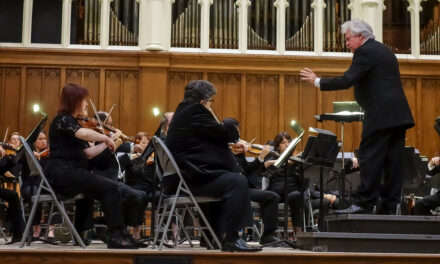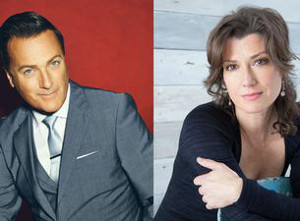Take 220 young orchestral musicians and pianists between the ages of 14 and 22 which form the student body of the prestigious Eastern Music Festival, all winners of auditions of over a thousand young musicians world-wide, and you have a highly combustible pool of talent, poised to erupt on any stage at any time! Put them through a rigorous selection process involving a jury of highly trained world-class virtuosi and pedagogues and you are bound to come up with some incredibly gifted young soloists. Two back-to-back concerts present these young winners accompanied by their peers to the audiences of the EMF in the closing days of the Festival.
Most instrumentalists will find fulfillment as orchestral or chamber musicians with occasional excursions onto the lip of the stage as soloists, while a lucky few will have independent solo careers, mostly violinists and pianists. It was, therefore, with special enthusiasm that the audiences welcomed concertos for double bass, bassoon, oboe, and flute as well as the predictable violinist and pianist. Dividing the six soloists between the two excellent student orchestras, with their respective maestri, José-Luis Novo and new-comer Grant Cooper, each concert also presented a pair of orchestral show-stoppers on the second half of the program.
Karen Baumgartner, 19, from Roseville, MN opened the Thursday evening concert with the first movement of Carl Nielsen’s raw and schizophrenic Concerto for Flute. She has a polished and delicate tone, and more than enough technique to master the difficulties of Nielsen’s score. Lovely clarinet solos (Mary Fortino) and rude interruptions by the trombone (Gustave Wilde) added to the interest and color of this intriguing concerto.
William Karns, 18, a double bass player from Moore, TX, gave a convincing performance of Giovanni Bottesini’s Double Bass Concerto No. 2, in B minor, a concerto which allows the usually low and gruff instrument to soar into the upper violin register. Great intonation and a brilliant coda after the cadenza brought down the house as his colleagues gave him a boisterous standing ovation.
More discrete and subtle was the somber and lovely First Movement of Henri Wieniawski’s 2nd Violin Concerto in D Minor, Op. 22, beautifully and sensitively played by 16-year-old Nathalie Schmalhofer from Augsburg, Germany. Playing it safe, she wisely eschewed the flying spiccato no doubt written to satisfy the virtuosity of Pablo de Sarasate, for whom the concerto was written. Her playing was sensitive, musical and expressive, as was the orchestral accompaniment, deftly and musically led by Maestro Novo.
On Friday night (July 26) we were treated to the Bassoon Concerto in E minor, RV 484, by Antonio Vivaldi, subtly played with a warm rich tone and great technique by Ben Roidl-Ward, 20, from Tacoma, WA. After lagging in part of the first movement, the continuo led by Morgan Little on cello showed itself worthy of the special bow granted by conductor Grant Cooper.
Tamara Winston tackled the first movement of the Concertino in F for Oboe, Op. 110 by Czech composer, Jan Kalivoda. Ms. Winston, 19, from Skokie, IL has a lovely tone and great technique and staccato tonguing, to say nothing of the ease with which she tackled the extreme highs and lows of her instrument.
Pianist Artur Wysoczanski, 18, from Wilbraham, MA, brought down the house with his performance of Franz Liszt’s warhorse, Totentanz (“Dance of Death”). Audiences usually react with explosive passion to works of this genre by Liszt and this audience was no exception. Quiet and modest in demeanor and wearing shoulder length locks, Wysoczanski had more than enough technique to master the difficulties of this virtuoso work (No, it was not note-perfect – but who cares!) with its glissandi, repeated notes, fugues and provocative harmonies. If there were a prediction to make from this week’s gaze into the crystal ball, it would include both Mr. Wysoczanski and the 16-year-old violinist from the previous night, Ms. Schmalhofer as destined to make careers as soloists.
In the all-orchestral second half of each concert, the conductors sought to close the season on a high note of orchestral virtuosity. On Thursday night, conductor Grant Cooper chose two familiar twentieth-century works, Aaron Copland’s Four Dance Episodes from Rodeo and Maurice Ravel’s familiar Boléro. Brisk tempos and crisp rhythms kept the Copland interesting although sharp horns and bassoons in the second movement (“Corral Nocturne”) and a flat oboe in the “Saturday Night Waltz” were minor irritants – overcome by a great trombone solo in the midst of the rapid Hoe-down.
Boléro is a study in orchestration and obsessive repetition and as such is one of the most difficult works in the repertory. Each iteration of the two themes increases the density of tone by adding overtones, starting with single winds and ending with choirs of instruments. When no more instruments can be added nor loudness, Ravel shortens the themes and eventually modulates from “C” to “E” for a few measures before raucously returning to “C” and ending in a short blaring coda. Rarely is the work a critical success because of the need for perfection in each solo – no bumps on opening notes or burps in glissandos – just perfectly executed solos and perfectly balanced ensembles. However, the work is always a popular success, as it was Thursday night!
Friday evening after the three soloists had played and the stage was reset, Maestro Novo led his young charges in the 3rd movement of the rarely-heard Symphony No. 3 “Ilya Muromets,” Op. 42, by Soviet composer Reinhold Glière. Brilliant and flashy were words that leapt into mind while listening to the unfamiliar movement subtitled “Festival in the Palace of Prince Vladimir.” I highly recommend it to readers unfamiliar with the music of Glière! The concert closed with a rousing performance of the Suite from the opera The Love for Three Oranges by Sergei Prokofiev. The six movements include the very familiar March and Scherzo as well as some lesser known excerpts of the comic opera, ending rather abruptly on the “Escape” music, a sort of diabolic moto perpetua taxing the speed and strength of the strings!
Just as the quality of the professional Eastern Festival Orchestra has grown steadily into a refined virtuoso ensemble under the leadership of Maestro Schwarz, so has the level of playing of the two student ensembles shown continuous improvement despite constant turnover of personnel from year to year. The EMF is on a roll! Bravo, all!












